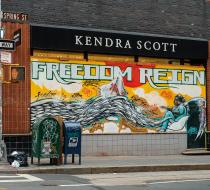When Luxury Stores Decorate Their Riot Barricades With Protest Art 1 Favorite
Three months ago, when New York government officials ordered nonessential businesses closed to slow the spread of coronavirus, high-end retailers sheathed their stores in plywood barriers, as though readying for civil unrest.
Did Louis Vuitton and Coach anticipate this human rights movement catalyzed by the police killing of George Floyd? Probably not. The reflexive impulse to protect property is a deeply American one, ingrained in this country’s foundation and upheld more consistently than probably anything else. Luxury stores seized in flimsy plywood are a neat visual synecdoche for a country governed more by fear than sense.
The effect of seeing entire commercial districts embalmed in plywood is jarring, a hostile landscape of bland, beige blankness. In the graffiti tradition, the presence of blankness is known as “fresh walls,” its precious existence an invitation answered gleefully with tags and pieces activated not just by the defiance of their making, but also by being seen — an affirmation of humanity. In the absence of in-person commerce, looking becomes heightened. It feels like a miracle of restraint that New York’s street artists largely heeded the public health emergency and stayed home, leaving most of the city’s rolling plywood fields undisturbed.
In the last few weeks, however, as the country convulsed into protests against police brutality that were met with more police brutality, that inertia began to give way. In New York, some retail stores, previously content to leave their plywood barriers blank when no one was around to see them, and others newly boarded, began deploying artwork ostensibly directed at the protests.
The Museum of Ice Cream in SoHo painted a brand-consistent bubble-gum pink tribute to black victims of police violence under the unfortunate preamble “I SCREAM FOR ...” After receiving criticism for insensitivity, the museum’s founder apologized, had the preamble removed and repainted the plywood black. After its windows were smashed, Kith, a brand that pulped hip-hop and streetwear culture into a smooth simulacrum that traffics in notions of community, encased its entire frontage in a massive black box painted with a three-story quote from Nelson Mandela that seemed more interested in aesthetics than coalition.
The worst of these offer the same ambiguous sentimentality and vague uplift that upscale stores like Club Monaco were already employing before the protests began. The Hanro store next door to the Whitney (its own glass walls blotted out with boards) declares “Love. Unity. Respect.,” a tepid platitude that signifies nothing in the face of righteous unrest.
It’s not hard to identify a brand’s motivation here: wanting to soften the brutal optics of its own self-interest. As thousands of New Yorkers emptied into the streets in recent weeks, some image consultants correctly identified that their brands would be caught naked. Earlier this month, the artist Shantell Martin shared a screenshot on Instagram of an email she said she received from the advertising firm McCann, soliciting her to create a Black Lives Matter mural on Microsoft’s boarded Fifth Avenue store “while the protests are still relevant.” Such language gave the lie to what Ms. Martin called “performative allyship.”
Art can soothe, but it can also manipulate, cajoling pacification when rage is more appropriate.
The most immediate problem with these kinds of murals is that they exist under the pretext of looting — or rather the perceived, racialized threat of looting, the material impact of which hardly skims the existential one that protests seek to redress. It is simply impossible to call for racial equality with a gesture that prioritizes property value. The cognitive dissonance of a store commissioning a graphic representation of Martin Luther King Jr.’s assertion that a riot is the “language of the unheard” on its riot-proof barricade would be parodic if it weren’t so damning.
Because rioting is a legitimate expression of pain, the active, exuberant presence of materials designed to dampen that expression can be viewed as unsympathetic, even antagonistic. This moment has, again, exposed the limits of corporate solidarity, designed more to defend shareholder integrity than agitate for social justice.
All of these examples are distinct from the protest art, murals, posters and graffiti writing on trains and elsewhere commemorating the lives of Mr. Floyd, Breonna Taylor, Kimani Gray, Tamir Rice and other black Americans killed by the police, or in other acts of racial violence, that have sprouted in nearly every major American city. In SoHo one recent weekend, I watched artists quietly add their own murals to blank squares of plywood, forming an open-air gallery of genuine grief and solidarity, untethered by commercial interests. Their message is unequivocal. The images are genuine because they serve all of us.
By Max Lakin
June 22, 2020
New York Times











